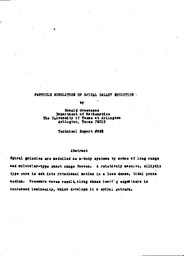
ATTENTION: The works hosted here are being migrated to a new repository that will consolidate resources, improve discoverability, and better show UTA's research impact on the global community. We will update authors as the migration progresses. Please see MavMatrix for more information.
Show simple item record
| dc.contributor.author | Greenspan, Donald | en |
| dc.date.accessioned | 2010-06-08T16:42:54Z | en |
| dc.date.available | 2010-06-08T16:42:54Z | en |
| dc.date.issued | 1985 | en |
| dc.identifier.uri | http://hdl.handle.net/10106/2374 | en |
| dc.description.abstract | **Please note that the full text is embargoed** ABSTRACT: Spiral galaxies are modelled as n-body systems by means of long range and molecular-type short range forces. A relatively massive, elliptic, type core is sit into rotational motion in a less dense, tidal prone medium. Pressure waves result along whose leading edges there is increased luminosity, which develops in a spiral pattern. | en |
| dc.language.iso | en_US | en |
| dc.publisher | University of Texas at Arlington | en |
| dc.relation.ispartofseries | Technical Report;228 | en |
| dc.subject | Spiral galaxies | en |
| dc.subject | n-body systems | en |
| dc.subject | Gravitation | en |
| dc.subject | Density wave development | en |
| dc.subject | Computer simulation | en |
| dc.subject.lcsh | Astrophysics | en |
| dc.subject.lcsh | Mathematics Research | en |
| dc.title | Particle Simulation of Spiral Galaxy Evolution | en |
| dc.type | Technical Report | en |
| dc.publisher.department | Department of Mathematics | en |
Files in this item
- Name:
- MathTechReport228.pdf
- Size:
- 847.4Kb
- Format:
- PDF
- Description:
- PDF
This item appears in the following Collection(s)
Show simple item record


